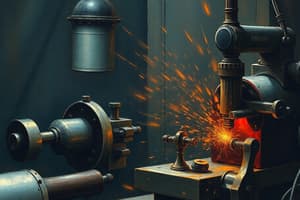Podcast
Questions and Answers
What is a potential issue with large positive rake angles at high cutting speeds?
What is a potential issue with large positive rake angles at high cutting speeds?
- Tool breakage is more likely (correct)
- Surface finish deteriorates
- Tool wear increases
- Chip removal is less efficient
Which type of tools are generally preferred for materials like ceramic and diamond due to their hardness and low toughness?
Which type of tools are generally preferred for materials like ceramic and diamond due to their hardness and low toughness?
- Tools with positive rake angles
- Cemented carbide tools
- High-speed steel tools
- Tools with negative rake angles (correct)
In what range are rake angles typically used for cemented carbide tools?
In what range are rake angles typically used for cemented carbide tools?
- -10° to -15°
- 0° to 5°
- -20° to -25°
- -5° to -10° (correct)
What characteristic makes materials like ceramics suitable for negative rake angles?
What characteristic makes materials like ceramics suitable for negative rake angles?
Why do negative rake angles provide greater strength at the cutting edge?
Why do negative rake angles provide greater strength at the cutting edge?
What is a common downside associated with negative rake angles in terms of surface finish?
What is a common downside associated with negative rake angles in terms of surface finish?
How does a positive rake angle affect the tool's strength at the cutting edge?
How does a positive rake angle affect the tool's strength at the cutting edge?
What is the primary advantage of negative rake angles in terms of cutting forces?
What is the primary advantage of negative rake angles in terms of cutting forces?
Which type of tools are more prone to tool failure under large positive rake angles?
Which type of tools are more prone to tool failure under large positive rake angles?
In which scenario are high positive rake angles more likely to cause tool breakage?
In which scenario are high positive rake angles more likely to cause tool breakage?
Flashcards are hidden until you start studying
Study Notes
Cutting Tool
- A cutting tool has one or more sharp cutting edges and is made of a material harder than the work material.
- The cutting edge serves to separate a chip from the parent work material.
Single-Point Cutting Tool
- A single-point tool has one cutting edge and is used for operations such as turning.
- The cutting edge is usually rounded to a certain radius, called the nose radius.
- During machining, the point of the tool penetrates below the original work surface of the part.
Multi-Point Cutting Tool
- Multiple-cutting-edge tools have more than one cutting edge and usually achieve their motion relative to the workpart by rotating.
- Drilling and milling use rotating multiple-cutting-edge tools.
Tool Geometry
- The rake face is the surface over which the chip, formed in the cutting process, slides.
- The flank face is the surface(s) over which the surface, produced on the workpiece, passes.
- The cutting edge is a theoretical line of intersection of the rake face and the flank surfaces.
- The cutting wedge is the tool body enclosed between the rake and the flank faces.
- The wedge angle is defined as the angle between flank and rake face.
Rake Angle
- Positive rake angle tools have a thinner cross section, which can cause tool breakage with high cutting speeds or intermittent cuts.
- Negative rake angles are generally preferred for ceramic, diamond, and cubic boron nitride tools due to their brittle nature.
- Negative rake angles provide greater strength at the cutting edge, better heat conductivity, and a poorer surface finish.
- Negative rake angles make the tool more blunt, increase the strength of the cutting edge, cause high compression, and increase the cutting forces.
Studying That Suits You
Use AI to generate personalized quizzes and flashcards to suit your learning preferences.




